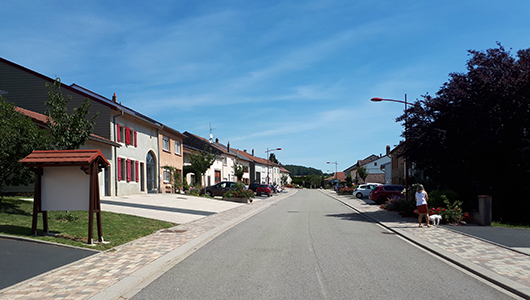Fraquelfing
Durée visite : 30 minutes
Moyen : Pédestre
Ce village, peuplé de 86 habitants aujourd’hui, a appartenu au domaine forestier de l’abbaye cistercienne de Haute-Seille. Il passa avec Phalsbourg à la Lorraine, puis à la France en 1661, grâce au traité de Vincennes. Son nom proviendrait du patronyme germanique Waraculf. Des restes de villa gallo-romaine et un cimetière mérovingien y ont été découverts.
This village, populated by 86 inhabitants today, belonged to the forest estate of the Cistercian abbey of Haute-Seille. It passed with Phalsbourg to Lorraine, then to France in 1661, thanks to the Treaty of Vincennes. Its name comes from the Germanic surname Waraculf.
Dieses Dorf mit heute 86 Einwohnern gehörte zum Waldgut der Zisterzienserabtei Haute-Seille. Dank des Vertrags von Vincennes gelangte es mit Phalsbourg an Lothringen und dann 1661 an Frankreich. Sein Name leitet sich vom germanischen Familiennamen Waraculf ab.

Echiqueté d’argent et de sable au lion de sinople brochant.
Ce blason évoque les trouvailles gallo-romaines faites au XIXe siècle. En effet on a retrouvé sur le territoire de la commune une mosaïque et un lion en bronze vert.
Checked Argent and Sable a lion Vert debruising.
This coat of arms evokes the Gallo-Roman finds made in the 19th century. Indeed we found on the territory of the commune a mosaic and a lion in green bronze.
Argent und Sable überprüften einen Löwen, der Vert verletzte.
Dieses Wappen erinnert an die galloromanischen Funde aus dem 19. Jahrhundert. Tatsächlich fanden wir auf dem Gebiet der Gemeinde ein Mosaik und einen Löwen aus grüner Bronze.

Les insouciants, les indifférents
» L’intelligence et le moral y sont un peu en souffrance. » C’est ainsi que s’exprime le Dictionnaire statistique de la Meurthe en 1836. Il doit y avoir un brin de vérité puisque le sobriquet dit que les gens de ce village ont pris l’habitude d’éviter tout effort et qu’ils sont insensibles à la plupart des choses qui touchent ordinairement les autres personnes.
The careless, the indifferent
« Intelligence and morale are a little in pain there. » This is how the Statistical Dictionary of Meurthe expressed itself in 1836. There must be a grain of truth since the nickname says that the people of this village have a habit of avoiding all effort and that they are insensitive to most things that ordinarily affect other people.
Die Unvorsichtigen, die Gleichgültigen
„Intelligenz und Moral haben da ein wenig Probleme.“ So drückte sich 1836 das Statistische Wörterbuch von Meurthe aus. Darin muss ein Körnchen Wahrheit stecken, denn der Spitzname besagt, dass die Menschen in diesem Dorf die Angewohnheit haben, jede Anstrengung zu meiden, und dass sie gegenüber den meisten Dingen, die normalerweise andere Menschen betreffen, gefühllos sind.
Les points de visites
.
Cette bâtisse conserve sa porte grangière. A noter la présence de la statue mariale dans la niche au-dessus de la porte. C’est un gage de sauvegarde, très fréquent aussi bien dans les villes que dans les villages.
This building retains its barn door. Note the presence of the Marian statue in the niche above the door. It is a guarantee of safeguard, very common both in cities and in villages.
Dieses Gebäude behält sein Scheunentor. Beachten Sie die Anwesenheit der Marienstatue in der Nische über der Tür. Es ist eine Schutzgarantie, die sowohl in Städten als auch in Dörfern sehr verbreitet ist.
.
.
Cette belle maison en pierre a été assez bien restaurée. Elle conserve les traces de son passé agricole, avec sa porte de grange, réduite pour devenir entrée de garage. Le linteau est d’époque avec sa niche désormais vide. Y prenait place un saint protecteur, lointain successeur des dieux lares du foyer romain.
This beautiful stone house has been fairly well restored. It retains traces of its agricultural past, with its barn door, reduced to become a garage entrance. The lintel is from the period with its now empty niche. There sat a patron saint, a distant successor to the Lares gods of the Roman hearth.
Dieses schöne Steinhaus wurde ziemlich gut restauriert. Es bewahrt Spuren seiner landwirtschaftlichen Vergangenheit, mit seinem Scheunentor, das zu einer Garageneinfahrt wurde. Der Türsturz stammt aus der Zeit mit seiner jetzt leeren Nische. Dort saß ein Schutzheiliger, ein entfernter Nachfolger der Lares-Götter des römischen Herdes.
.
L’église Sainte-Anne date de 1731. Elle a été reconstruite en 1950. Ses autels sont du XVIIIe siècle. Sa chaire également du XVIIIe est signée Dominique Labroise. Avec son fils Joseph, il est un sculpteur réputé de Sarrebourg. Il fut ruiné par la vente des biens nationaux, sous la Révolution. Non mentionnée dans les quatre Évangiles canoniques, sainte Anne est la mère de la Vierge Marie. Leurs cultes sont étroitement liés. L’iconographie chrétienne en est le reflet (Léonard de Vinci par exemple)
The Sainte-Anne church dates from 1731. It was rebuilt in 1950. Its altars are from the 18th century. Its pulpit, also from the 18th century, is signed Dominique Labroise. With his son Joseph, he is a renowned sculptor from Sarrebourg. It was ruined by the sale of national property during the Revolution. Not mentioned in the four canonical Gospels, Saint Anne is the mother of the Virgin Mary. Their cults are closely linked. Christian iconography reflects this (Leonardo da Vinci for example)
Die Kirche Sainte-Anne stammt aus dem Jahr 1731. Sie wurde 1950 wieder aufgebaut. Ihre Altäre stammen aus dem 18. Jahrhundert. Seine Kanzel, ebenfalls aus dem 18. Jahrhundert, ist mit Dominique Labroise signiert. Mit seinem Sohn Joseph ist er ein renommierter Bildhauer aus Saarburg. Es wurde durch den Verkauf von Staatseigentum während der Revolution ruiniert. In den vier kanonischen Evangelien nicht erwähnt, ist die heilige Anna die Mutter der Jungfrau Maria. Ihre Kulte sind eng miteinander verbunden. Die christliche Ikonographie spiegelt dies wider (Leonardo da Vinci zum Beispiel)








